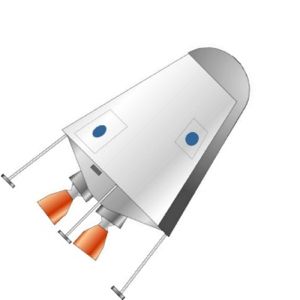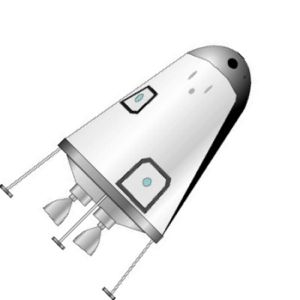
Home - Search - Browse - Alphabetic Index: 0- 1- 2- 3- 4- 5- 6- 7- 8- 9
A- B- C- D- E- F- G- H- I- J- K- L- M- N- O- P- Q- R- S- T- U- V- W- X- Y- Z
CEV Schafer
 CEV Schaefer Credit: © Mark Wade |
Status: Study 2012. Thrust: 133.30 kN (29,967 lbf). Gross mass: 11,000 kg (24,000 lb). Height: 8.30 m (27.20 ft). Diameter: 5.00 m (16.40 ft).
The Shafer CEV would have an empty mass of from 8 to 16 metric tons, 11 metric tons nominal, and be able to support four crew for 17 days. 500 kg of payload could be returned in addition to the crew. The CEV would be reusable and have adequate internal propellant and for 3.07 km/sec delta-V - sufficient for trans-earth injection direct from the lunar surface. Shafer's study showed that with a CEV of this size, NASA could take humans to the moon and Mars, while using commercial EELV boosters. The CEV provided adequate radiation shielding for all mission phases and had on any-time abort capability to return to earth. A backup rescue CEV would be on standby for launch from the earth at all times. The lunar exploration plan included docking with additional fuel tanks cached via separate launches to LEO and L1. These would be used to take the CEV from LEO to L1, from L1 to the lunar surface, and then on a direct flight from the lunar surface to reentry in the earth's atmosphere. Elements of the lunar exploration scheme included:
- CEV with external propellant tanks. No separate LSAM lunar lander would have to be developed, since the CEV would itself conduct the landing.
- EELV Cargo Launch System (25 metric ton nominal payload to 407 km low earth orbit - Delta IV Heavy, Atlas V 522, and/or Atlas V Heavy)
- Human Rated Launch System (Modified commercial EELV, with payload reduced 10% from the Cargo Launch System due to man-rated redundancy features and margins).
- In-Space Cargo Transport stage - 24 metric tons fueled, each capable of delivering 13 metric tons to L1.
For the baseline lunar mission, a total of 199 metric tons of payload would have to be delivered to low earth orbit in nine EELV launches. First, four EELV launches would put four Cargo Transport stages into LEO. These would dock with each other, then with 49 metric tons of external tanks and propellant. The propellant would be delivered to L1 by the transport stages. Another two launches would put 32 metric tons of drop tanks and propellant into LEO. Finally, a man-rated EELV would put the CEV into LEO. It would dock with the 32-metric tons of tanks, then use that propellant to take it to L1. There, it would rendezvous with the landing tanks, and head for the lunar surface.
For lunar bases, additional elements would be introduced. These would include a 30 metric ton L1 cargo transporter, that would move 13 metric tons of payload from L1 to the lunar surface; a 13 metric ton lunar base module, which would provide crew with 30 to 90 days of lunar stay time; and an ISRU plant. If lunar propellant production by the ISRU plant was sufficient, the L1 cargo transporter could be refueled and be used to cache lunar-produced propellant at L1 rather than transporting that from earth.
Crew Size: 4. Orbital Storage: 17 days.
Family: Lunar Bases, Manned spacecraft, Moon. Country: USA. Propellants: Lox/LH2. Agency: NASA, Schafer.
 | CEV Schaefer Credit: Mark Wade |
Back to top of page
Home - Search - Browse - Alphabetic Index: 0- 1- 2- 3- 4- 5- 6- 7- 8- 9
A- B- C- D- E- F- G- H- I- J- K- L- M- N- O- P- Q- R- S- T- U- V- W- X- Y- Z
© 1997-2019 Mark Wade - Contact
© / Conditions for Use